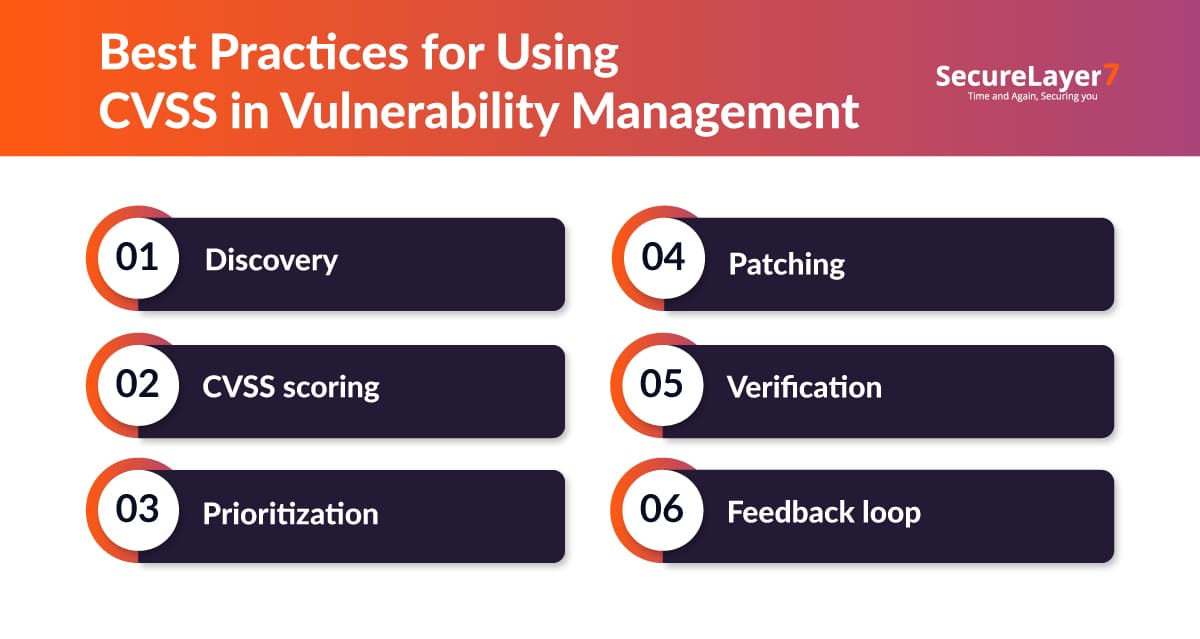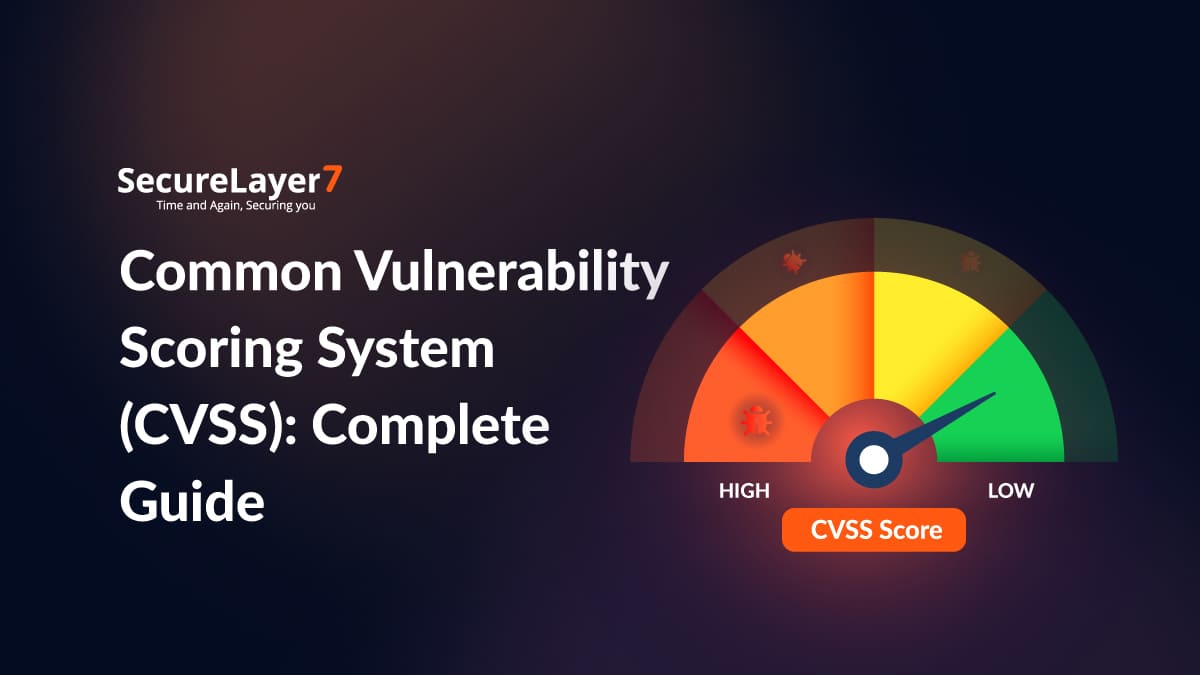The Common Vulnerability Scoring System (CVSS) is an open, standardized framework used to measure and communicate the severity of security vulnerabilities in software and information systems. By assigning a score from 0 to 10, CVSS helps organizations consistently assess the level of risk and prioritize remediation efforts. The scoring methodology evaluates factors such as exploitability, impact, and the potential consequences of exploitation, enabling security teams to convert technical findings into clear, actionable risk ratings that guide patching and resource allocation.
Widely adopted by security vendors, researchers, and regulatory bodies, CVSS has become the global benchmark for vulnerability management. It is maintained by the Forum of Incident Response and Security Teams (FIRST) and integrated into major repositories like the National Vulnerability Database (NVD).
Cybersecurity Vulnerabilities and Why Organizations need a standard method to measure severity
Cybersecurity vulnerabilities are weaknesses in software, hardware, or processes that attackers can exploit to gain unauthorized access, steal data, or disrupt services. With thousands of new vulnerabilities disclosed every year, businesses often struggle to understand which flaws pose the biggest risks. Not all vulnerabilities are equally dangerous – some might allow full system compromise, while others may cause only minimal disruption.
Without a standardized method of measuring severity, organizations risk misallocating resources. Critical vulnerabilities may go unpatched, while less severe issues consume valuable time and effort. To maintain a strong security posture, teams need a common language for describing the impact of vulnerabilities and deciding which ones require urgent action.
Common Vulnerability Scoring System (CVSS)
The Common Vulnerability Scoring System (CVSS) was developed to solve this exact challenge. It provides a consistent, vendor-neutral framework for evaluating the severity of security vulnerabilities. Instead of leaving the interpretation open to subjective judgment, CVSS assigns a score on a scale of 0 to 10 – where higher scores indicate more severe vulnerabilities.
This scoring system is recognized globally and adopted by organizations, vendors, and security professionals alike. By using CVSS, stakeholders across industries can rely on a standardized approach to assess, compare, and prioritize vulnerabilities, ensuring better risk management and decision-making.
What CVSS is, how the scoring works, and why it matters for security teams
The purpose of this blog is to serve as a complete guide to the Common Vulnerability Scoring System (CVSS). We’ll explore what CVSS is, the history of its development, and how the scoring methodology works – including base, temporal, and environmental metrics. More importantly, we’ll discuss why CVSS matters for security teams and how it helps them:
- Prioritize remediation efforts by addressing the most dangerous vulnerabilities first.
- Improve communication between technical teams, management, and external stakeholders.
- Enhance compliance and reporting by aligning with industry standards.
What is the Common Vulnerability Scoring System (CVSS)
The Common Vulnerability Scoring System (CVSS) is a standardized framework that rates the severity of security vulnerabilities on a 0.0 to 10.0 scale. Developed by the Forum of Incident Response and Security Teams (FIRST), it provides a universal method for organizations, vendors, and security teams to describe and communicate risks consistently, avoiding subjective or vendor-specific ratings.
CVSS scores are based on three metric groups: Base (inherent characteristics), Temporal (factors that change over time), and Environmental (organization-specific context). This structured scoring makes CVSS the global standard, widely adopted in the National Vulnerability Database (NVD) and compliance frameworks.
Definition of CVSS: Common Vulnerability Scoring System (CVSS Scoring System)
The Common Vulnerability Scoring System (CVSS) is an open and public scoring system used by organizations worldwide to assess the severity of information security vulnerabilities. CVSS assigns each vulnerability a score from 0 – 10, with higher scores indicating greater severity. These scores help security teams decide which threats require urgent attention and prioritize remediation efforts.
CVSS scores are calculated using a blend of metrics that assess how a vulnerability can be exploited, its impact on system confidentiality, integrity, and availability, and the characteristics of the affected environment.
Why CVSS Is the Global Standard for Measuring Vulnerability Severity
Today, the Common Vulnerability Scoring System is regarded as the global standard for vulnerability severity assessment. Its widespread adoption by security vendors, enterprises, and government organizations highlights its importance.
Key reasons for its global standard status include:
- Consistency: CVSS offers a universal scale (0–10) that can be understood by both technical and non-technical stakeholders.
- Transparency: The methodology behind each score is publicly documented, making it reliable and verifiable.
- Adoption: Major vulnerability databases, such as the U.S. National Vulnerability Database (NVD), rely on CVSS scores for ranking and prioritization.
- Actionability: Security teams use CVSS to prioritize patching, allocate resources, and strengthen overall risk management strategies.
Why CVSS Matters in Cybersecurity
The growing volume of vulnerabilities discovered each year makes it nearly impossible for organizations to address them all at once. This is where the vulnerability scoring system offered by CVSS proves invaluable – it gives security teams a structured way to determine which vulnerabilities should be fixed immediately and which can be scheduled for later remediation.
Integrating SAST and DAST early in pipelines helps generate vulnerabilities that CVSS can help prioritize – as explained in our SecureLayer7 post OWASP M2: Inadequate Supply Chain Security Explained.
How CVSS Prioritizes Security Vulnerabilities
CVSS scores provide a numerical severity rating (from 0 to 10) for vulnerabilities based on exploitability and impact metrics, which allows organizations to prioritize remediation efforts effectively.
By using CVSS:
- CVSS facilitates communication across technical and non-technical stakeholders by providing a common language for severity.
- Security teams can focus on high and critical vulnerabilities (typically scores of 7.0 and above) that pose the greatest risk to confidentiality, integrity, and availability.
- It removes subjective bias by providing objective criteria to assess vulnerabilities across platforms and applications uniformly.
- Automated vulnerability management tools integrate CVSS scores to trigger patching workflows and reduce human errors, speeding up response times.
The Role of CVSS in Vulnerability Management, Patching & Compliance
The CVSS framework is essential in vulnerability management programs by enabling:
- Systematic risk prioritization that aligns remediation activities with organizational risk posture and resource capacity to reduce exposure strategically.
- Informing patch management decisions by highlighting vulnerabilities that require immediate attention and monitoring less critical ones.
- Meeting requirements of compliance frameworks such as PCI DSS, HIPAA, NIST, and ISO 27001, which often specify CVSS-based vulnerability thresholds for remediation timelines.
- Supporting security audits through documented evidence of vulnerability triage and remediation based on CVSS scores, helping organizations demonstrate due diligence to regulators.
See how vulnerability scanning tools use CVSS in classifying risk in our post The Pros and Cons Of Vulnerability Scanning Tools.
How CVSS Scoring Works
The Common Vulnerability Scoring System (CVSS) determines the severity of security vulnerabilities by analyzing multiple factors and translating them into a score between 0.0 and 10.0. This scoring process relies on three metric groups – Base, Temporal, and Environmental – which together capture the inherent characteristics of a vulnerability, how its risk changes over time, and its impact within a specific organization’s environment.
CVSS Score Ranges Explained
At the heart of the CVSS framework is its 0.0 to 10.0 scale, where each score corresponds to a level of severity. This range provides a common reference point for both technical and non-technical stakeholders, ensuring everyone interprets vulnerability risk in the same way.
Use of 0.0 to 10.0 scale
- 0.0 – None: No impact or a negligible vulnerability. Typically requires no action.
- 0.1 – 3.9 (Low Severity): Limited impact, often difficult to exploit. Organizations may address these during routine maintenance cycles.
- 4.0 – 6.9 (Medium Severity): Noticeable impact with moderate exploitability. Should be patched, but not as urgently as higher scores.
- 7.0 – 8.9 (High Severity): Significant impact on systems or data. These vulnerabilities are relatively easy to exploit and should be prioritized.
- 9.0 – 10.0 (Critical Severity): Severe vulnerabilities that could lead to full system compromise or widespread damage. Immediate remediation is required.
The Three Metric Groups
The Common Vulnerability Scoring System (CVSS) uses three distinct metric groups to assess the overall severity of a security vulnerability. These metrics capture various attributes to generate a comprehensive and standardized score ranging from 0.0 to 10.0.
Base Metrics – Inherent Characteristics of a Vulnerability.
Base metrics define the fundamental qualities of a vulnerability that do not change over time or across environments. They measure how the vulnerability can be exploited and what kind of impact it might cause.
Key factors include:
- Attack Vector (AV): Whether the vulnerability can be exploited remotely or requires local access.
- Attack Complexity (AC): The difficulty of carrying out the exploit.
- Privileges Required (PR): The level of user access needed to exploit the flaw.
- User Interaction (UI): Whether exploitation requires a user to take an action, like clicking a link.
- Impact (Confidentiality, Integrity, Availability): The potential damage to data and systems.
Temporal Metrics – Factors that Change Over Time
Temporal metrics reflect conditions that may evolve after the vulnerability is discovered. These factors help adjust the base score to show the vulnerability’s severity at a specific point in time.
Key factors include:
- Exploit Code Maturity: Whether exploit code is theoretical, proof-of-concept, or fully available.
- Remediation Level: Whether a fix is available, temporary, or not yet provided.
- Report Confidence: How reliable the information about the vulnerability is.
Environmental Metrics – Factors Unique to Each user’s Environment
Environmental metrics capture the context of the affected organization. These factors adjust the score to reflect how critical a vulnerability is in a specific environment.
Key considerations include:
- Security Requirements: The importance of confidentiality, integrity, and availability for the organization.
- Modified Impact Metrics: How the vulnerability’s potential impact aligns with the organization’s systems and assets.
Real-world Examples from NVD (National Vulnerability Database).
The National Vulnerability Database (NVD) applies CVSS scores to all published vulnerabilities. A few examples:
- CVE-2021-44228 (Log4Shell): Rated CVSS 10.0 (Critical) due to its ease of exploitation and potential for full system compromise across environments.
- CVE-2022-30190 (Follina – Microsoft MSDT): Initially scored lower, but the availability of public exploits raised its Temporal score, pushing it into a higher severity range.
- CVE-2020-0601 (CurveBall – Windows CryptoAPI Spoofing): Scored differently depending on the Environmental metrics, since the impact varied between government systems and less sensitive networks.
CVSS Versions and Evolution
Since its launch in 2005, the Common Vulnerability Scoring System (CVSS) has gone through several updates to keep pace with evolving cyber threats and industry needs. Each version – v1, v2, v3.0, and the current v3.1 – introduced improvements that made the scoring process more accurate, transparent, and practical for real-world vulnerability management.
CVSS v1 > v2 > v3.0 > v3.1 (current)
CVSS v1 (2005)
- Developed as the first attempt at a universal framework for scoring vulnerabilities.
- Provided a foundation but lacked precision and consistency in real-world use.
- Adoption was limited due to complexity and lack of clarity.
CVSS v2 (2007)
- Simplified scoring to make it more understandable and widely applicable.
- Introduced clearer Base, Temporal, and Environmental metrics.
- It became widely adopted, with the U.S. National Vulnerability Database (NVD) using it as the standard.
- Limitations: Did not fully capture modern attack vectors like privilege escalation and user interaction.
CVSS v3.0 (2015)
- Addressed gaps in CVSS v2 by adding more detailed Base metrics (e.g., Privileges Required and User Interaction).
- Improved granularity, allowing for more accurate scoring.
- Offers better differentiation between vulnerabilities with similar technical characteristics but different real-world impacts.
CVSS v3.1 (2019 – Current Version)
- Released by FIRST to improve clarity in documentation and guidelines.
- Maintained the same scoring equations as v3.0 but clarified definitions to reduce scoring inconsistencies.
- Remains the current global standard for vulnerability assessment and is used by organizations worldwide.
Key Improvements Across Versions
| Version | Key Improvements |
| v1 (2005) | Initial framework for universal severity scoring |
| v2 (2007) | More granularity, better consistency, broader adoption |
| v3.0 (2015) | Added new exploitability and impact metrics, severity categories |
| v3.1 (2019) | Clarified definitions and usability, introduced extension framework |
| v4.0 (2023) | Enhanced granularity, wider applicability, supplemental attributes |
Examples of CVSS in Action
The true value of the Common Vulnerability Scoring System (CVSS) becomes clear when applied to real-world incidents. By assigning a consistent severity score, CVSS helps organizations decide how quickly to respond and what resources to allocate.
High-profile vulnerabilities like Log4j (CVE-2021-44228), which received a maximum CVSS score of 10.0, highlight how critical flaws demand immediate global action, while lower-scored issues may be addressed through routine patch cycles. Following examples show how CVSS serves as a practical guide for prioritizing threats in everyday cybersecurity operations.
Case Study: Recent Vulnerability Analysis with CVSS Score
The most notable vulnerability in recent history is Log4j (CVE-2021-44228), a critical security flaw discovered in the widely used Apache Log4j Java logging library. This vulnerability received the highest possible CVSS score of 10.0, signalling its critical severity and ease of exploitation.
The flaw allowed remote code execution without requiring authentication, making it extremely dangerous. The National Vulnerability Database (NVD) and security authorities swiftly assigned this maximum severity score, triggering immediate and global remediation efforts.
How CVSS Scores Shape Vulnerability Response Priorities
The perfect CVSS score of 10.0 for the Log4j vulnerability meant the following for affected organizations:
- Rapid prioritization for patching or mitigation, overriding lower-scored vulnerabilities.
- Emergency response and security advisories issued by major cloud providers, software vendors, and enterprises worldwide.
- Deployment of temporary mitigations to reduce impact while patching progressed, due to the active exploitation in the wild.
- Heightened monitoring and incident response readiness to detect potential exploitation attempts.
Example: Log4j Vulnerability Scoring and its Industry Response
The Log4j vulnerability exposed an urgent need for a universally understood vulnerability scoring system like CVSS. With its critical score of 10.0, the vulnerability rapidly mobilized developers, security teams, and vendors to:
- Release patches and updates quickly, such as Log4j version 2.15.0 and subsequent fixes.
- Issue detailed advisories by cybersecurity organizations like CISA and NIST.
- Conduct widespread vulnerability scanning and asset discovery efforts to identify affected systems.
- Elevate awareness in boardrooms to secure resources for addressing the critical threat.
Benefits and Limitations of CVSS
The Common Vulnerability Scoring System (CVSS) has become the global benchmark for rating vulnerability severity, offering organizations a consistent way to prioritize risks and guide remediation. Like any framework, It has both strengths and drawbacks.
While CVSS brings clear benefits such as standardization, widespread adoption, and compliance support, it also faces criticism for being too generic and not always reflecting organization-specific risks.
Benefits
- Universal Standardization: CVSS offers a globally accepted and open framework that standardizes how vulnerabilities are scored, enabling consistent communication of severity across industries, vendors, and security teams.
- Widespread Use in Vulnerability Databases and SIEM Tools: Scores based on CVSS are integrated into major public vulnerability databases like the National Vulnerability Database (NVD) and widely utilized in security information and event management (SIEM) systems for automated risk assessment and prioritization.
- Supports Compliance and Audit Reporting: Many regulatory frameworks and compliance standards reference CVSS scores as part of their requirements for vulnerability management, helping organizations demonstrate due diligence during audits.
Limitations
- May Not Reflect Organization-Specific Risks: CVSS scores primarily represent the severity of vulnerabilities in an abstract, generalized manner. They do not inherently account for factors unique to an organization’s environment, such as asset criticality or specific security controls, which can lead to misaligned prioritization if used in isolation.
- Sometimes Criticized for Being Too Generic: The common nature of CVSS can overlook nuances in individual cases, and some security practitioners feel it can be overly simplistic or disconnected from actual risk scenarios, especially without including Temporal or Environmental metrics.
- Importance of Combining CVSS with Contextual Risk Analysis: To address these limitations, CVSS should be combined with comprehensive risk analysis that includes threat intelligence, business context, and environmental factors.
Best Practices for Using CVSS in Vulnerability Management

The effectiveness of the Common Vulnerability Scoring System (CVSS) depends on how organizations apply it within their security programs. While CVSS provides a standardized way to measure vulnerability severity, it works best when integrated into broader risk management practices. The following best practices help maximize the value of CVSS in day-to-day operations.
Integrating CVSS into Vulnerability Scanning and Patch Management
- Most modern vulnerability scanners (e.g., Nessus, Qualys, Rapid7) automatically generate CVSS scores for detected vulnerabilities.
- Use these scores to prioritize patching efforts, addressing Critical (9.0–10.0) and High (7.0–8.9) vulnerabilities first.
- Build patch management workflows that reference CVSS thresholds, e.g., patching Critical vulnerabilities within 24-48 hours.
- Automating ticket creation based on CVSS scores ensures faster response and less manual oversight.
Prioritize Vulnerabilities Accurately with Environmental Metrics
- CVSS Base scores provide a universal severity rating, but they don’t account for your organization’s unique environment.
- Apply Environmental metrics to adjust scores according to business context:
- If a vulnerability affects sensitive assets like payment systems or healthcare data, raise its priority.
- If the asset is isolated and has strong compensating controls, the risk may be downgraded.
- This tailored approach helps align security priorities with real business impact instead of treating all vulnerabilities equally.
Strengthening Security Posture with NIST, ISO 27001, and SOC 2 Frameworks
- CVSS should not be used in isolation – it works best as part of a broader risk management framework.
- Map CVSS scoring into NIST CSF or NIST 800-53 controls to ensure vulnerabilities are handled within a structured governance model.
- Use CVSS data to demonstrate compliance with ISO 27001 risk treatment plans and SOC 2 security principles.
- By integrating CVSS with these frameworks, organizations can strengthen both technical defenses and audit readiness.
Conclusion
The Common Vulnerability Scoring System (CVSS) has become the global standard for evaluating the severity of security vulnerabilities, providing organizations with a consistent framework to measure, compare, and prioritize risks. By translating complex technical flaws into clear numerical scores, CVSS enables security teams to focus their efforts where they matter most – protecting critical systems, reducing exposure, and meeting compliance obligations.
CVSS is most effective when used as part of a broader cybersecurity risk management strategy. Organizations should combine CVSS scores with contextual risk analysis, patch management programs, and governance frameworks like NIST, ISO 27001, and SOC 2.
At Securelayer7, we help organizations go beyond the numbers by combining CVSS-based vulnerability assessments with expert-driven penetration testing, compliance readiness, and threat intelligence. Our team ensures that vulnerabilities are not only scored but also remediated effectively in line with your business context.
Get in touch with Securelayer7 today to strengthen your vulnerability management program and stay ahead of evolving cyber threats.
Frequently Asked Questions (FAQs)
The Common Vulnerability Scoring System (CVSS) is a standardized framework for rating the severity of security vulnerabilities. It assigns a numerical score (0.0 to 10.0) that helps organizations understand the potential impact and prioritize their remediation efforts.
A CVSS score is calculated using three groups of metrics:
• Base Metrics: Inherent characteristics of a vulnerability (e.g., attack vector, impact).
• Temporal Metrics: Factors that change over time (e.g., availability of exploit code or patches).
• Environmental Metrics: Factors unique to an organization’s environment (e.g., data sensitivity, business impact). These produce a final score between 0.0 and 10.0.
• CVSS v2 (2007): Simplified the scoring process but lacked granularity for modern threats.
• CVSS v3.0 (2015): Introduced new metrics like Privileges Required and User Interaction.
• CVSS v3.1 (2019, current): Clarified definitions and improved scoring consistency, while keeping the same formula as v3.0.
CVSS provides a common, vendor-neutral standard that helps organizations:
• Prioritize vulnerabilities based on severity.
• Allocate resources effectively for patching.
• Meet compliance requirements (e.g., PCI DSS, ISO 27001).
Without CVSS, teams risk inconsistent and inefficient vulnerability management.
No. While CVSS is the most widely adopted system, other models exist – such as vendor-specific ratings or proprietary scoring used in some security tools. CVSS remains the global standard because it is open, transparent, and universally recognized.



